
Server Options
ROES currently has two major lab side server options available. The ROES DP2 Server only pushes orders directly into Kodak’s DP2 production system. The ROES Stand Alone Server has many different versions that enable labs to feed a number of our production system partners. To choose the server that best fits your workflow, see additional data below.
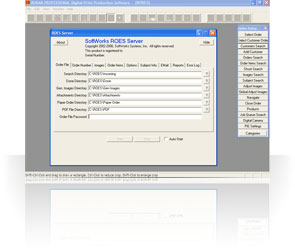
The ROES DP2 Server is integrated with Kodak’s DP2 software and processes ROES Client orders automatically. The Server finds the DP2 layout file referenced in the Client order, applies the crop generated in the Client, and creates DP2 order items and jobs, as if a user had manually entered them into DP2.
Added benefits of the ROES DP2 Server are the creation of order reports and emails, which are flexible, macro driven, and easily set up to be in plain text or HTML. Order completion emails are optionally sent to customers when their order is completed, so customers know their orders have entered the system. Schema 6 POF files are created for seamless integration into billing systems such as Bremsen, or we offer links into QuickBooks. Once a ROES Client order is processed by the ROES DP2 Server, the lab need only color correct and print.
Locations for order reports, completed order files, order images, and POF files are all configurable, allowing the Server to integrate into your current internal network. New features in the just released version of the ROES Server include easier layout location methods, expanded macro support, and improved support for retouch options. The automation of the ROES DP2 Server combined with the ease-of-use of the ROES Client creates not only a powerful order entry system from studio to lab, but an excellent front end for DP2 within a lab.
The SoftWorks ROES Stand Alone Servers are ideal for labs that desire the ability to utilize the ROES Client but are not using DP2 on the back end. For labs using Noritsu Hot Folders, Fuji PIC Pro, Frontline, Halse Systems, Xerox DocUSP or other back end systems we have the ROES Stand Alone Server. This is a stand alone Java application that can be run on any Java capable system in your lab. Your customers can create orders using a ROES Client branded to your lab. We provide a basic production-ready products and options listing that can be used almost immediately! All that is needed is your pricing and tailoring the listing to change the sizes and options to match your offerings! Click here to launch an example ROES Client that can be tailored for your lab and start your customers ordering online in just a few days!
Upon receiving the files via the Internet or CD, orders will be processed by the server. As with ROES DP2 Server, the orders are renumbered with a lab-defined numbering sequence, e-mail confirmations can be sent to the customer, and multiple lab-designed reports can be generated for each order.
Fuji PIC Pro
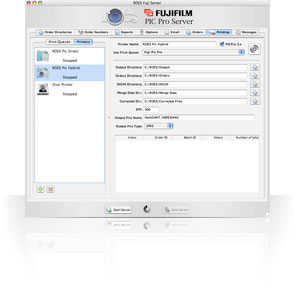
The ROES PIC Pro integration allows for 2 Fuji options - a PIC Pro Direct printer type and ROES PIC Pro hybrid printer type. Both of these versions can be used by the lab, with simple proof orders going to the PIC Pro Direct and orders of proof sheets and composites going to the ROES PIC Pro hybrid printer.
The PIC Pro Direct printer will take the processed order, create a formal Fuji order file and feed the order information and images into PIC Pro’s Merge Data, Order Data, and Digin. This supports use of base Fuji units as well as composites as created in the Fuji Template Tool, and allows for passing of image tones and studio logo files and placement into PIC Pro.
The new Fuji Hybrid printer allows for the ROES Server to process orders for all possible options affecting a print, including Pager-modified/created composites. The ROES Server processes the incoming order into PIC Pro initially to allow for correction, then the images are exported with the corrections into a defined folder. Once the export completes, the ROES Server uses the adjusted files to create the products called for and feeds them back into PIC Pro for printing with a formal Fuji order file.
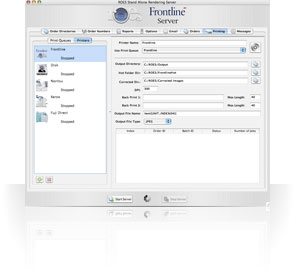
Frontline System
The ROES Server will feed orders into Frontline Systems, where images can be color corrected and exported back to ROES for full rendering of composite and Pager-modified items. Once rendered, the order is re-sent to Frontline with a formal XML order file to apply the images to Frontline units, such as 4x6L, 8x10G, etc.
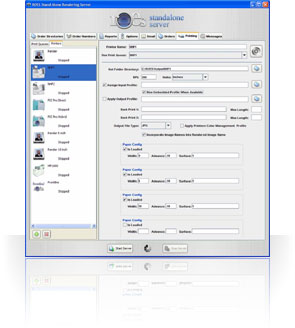
Noritsu Hot Folders
The Noritsu Hot Folder integration allows you to submit a single order to multiple paper roll sizes (up to 4) via a single printer setup and command file that the Noritsu will read in, giving it the information for each item and the image source to use. Multiple queues and printer types can be configured to service various paper surfaces and sizes. Products of all sizes can be created within the same order file and fed into their respective queues upon processing. The ROES server will convert inch units and paper widths/lengths/additional advances into millimeters for proper handling in the Noritsu.
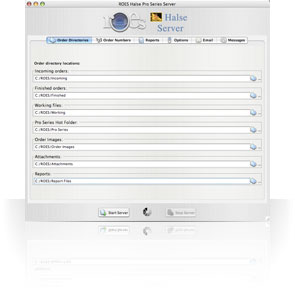
Halse Server
The Halse Server is integrated with Halse’s LS Lite Box and Pro Series software products and processes ROES Client orders automatically. The Server finds the Halse layout file referenced in the Client order, applies the crop generated in the Client, and creates Halse order files, as if a user had manually entered them into Halse.
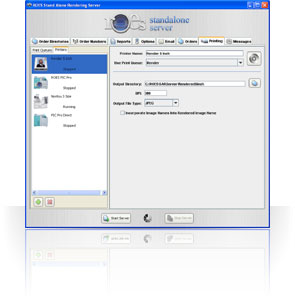
ROES Stand Alone Rendering Server
The ROES Rendering Server will render the products called for in the order out to a folder at a resolution that the lab defines. Rendering of the images can occur immediately upon order receipt or can be deferred if the lab chooses to do color correction of the entire original image. The rendered products can then be printed using whatever software you are using to drive your printers.
